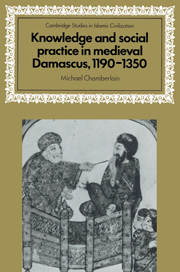Book contents
- Frontmatter
- Contents
- Preface
- List of abbreviations
- 1 Damascus and its surrounding region
- 2 Damascus in the thirteenth century
- Introduction
- 1 The acyān of Damascus, 590/1193–750/1350
- 2 Madrasas, the production of knowledge, and the reproduction of elites
- 3 Manṣabs and the logic of fitna
- 4 Social and cultural capital
- 5 Truth, error, and the struggle for social power
- Summary
- Bibliography
- Index
3 - Manṣabs and the logic of fitna
Published online by Cambridge University Press: 06 November 2009
- Frontmatter
- Contents
- Preface
- List of abbreviations
- 1 Damascus and its surrounding region
- 2 Damascus in the thirteenth century
- Introduction
- 1 The acyān of Damascus, 590/1193–750/1350
- 2 Madrasas, the production of knowledge, and the reproduction of elites
- 3 Manṣabs and the logic of fitna
- 4 Social and cultural capital
- 5 Truth, error, and the struggle for social power
- Summary
- Bibliography
- Index
Summary
A previous chapter has discussed how warriors ruled the city by making political and social use out of the foundation of “private” and “charitable” institutions such as waqfs. This chapter will examine the consequences for the aʿyān of the implantation of large numbers of household foundations in the city. The issue that this chapter will address is how the foundation of madrasas transformed aʿyān social strategies. It will suggest that the principal consequence of madrasas was to provide a package of prizes that changed the nature of ayn social competition.
To the aʿyān, madrasas were important religious and social institutions, with many purposes that had nothing to do with education. The learned elite not only often resided in madrasas, they used these institutions as stages for some of their important ceremonies, including the investiture of the chief qādī, Friday prayer, weddings, and ceremonies of mourning. The acyān also resided, housed visitors, and imprisoned one another in madrasas under their control.
Perhaps the major consequence of the foundation of madrasas in Damascus was the competition for manabs that resulted, and the transformation of elite social life that the proliferation of monetized honors inaugurated. It is difficult to deduce how many lecturers there were from the number of manabs available. Manabs were rarely held for a lifetime, many lecturers held more than one mansab, manabs were held like iqtācs and other property in “shares” (mushāraka) and many people were supported as “deputies” (nācib) of an absent lecturer.
- Type
- Chapter
- Information
- Publisher: Cambridge University PressPrint publication year: 1995

